16 Types of Crassula Varieties with Names and Pictures
Some links in this post may be affiliate links
Crassula Varieties are all succulent plants which bear fleshy leaves and are easy-care, low-maintenace plants when the right growing conditions are provided.
Crassula Succulents grow best in bright light with at least 4-6 hours of direct sunlight, average warmth, moderate humidity and loose, fast-draining succulents soil that is low in organic matter coupled with monthly feeding in the growing season.
They require good air circulation to discourage fungal diseases and to be protected or shielded from cold drafts as they affect growth negatively.

Watering is key for the healthy growth of Crassula Succulents as overwatering can be fatal leading to rotting and death of the plant. The best method of watering Crassula is the 'soak and dry' method which requires a thorough soaking of the soil followed by a drying out of the soil before the next watering.
Crassulas are easily propagated from stem cuttings, leaf cuttings, offshots (plantlets) borne at the base of the mother plant and by germinating seeds.
Crassula are CAM (Crassulacean Acid Metabolism) plants. These plants harvest Carbon dioxide at night and use it during the day to make their food. As they make their food, they store the oxygen they produce in the process and release it at night.
This is an adaptation of CAM plants to their drought-prone climate which enables then to survive the harsh climate. Therefore, growing these plants in your living spaces ensures a higher oxygen concentration and cleaning of the indoor air.
One disadvantage of Crassula plants is that they are toxic to human and pets. If ingested they can cause nausea, vomiting and diarrhea. Therefore, keep these plants away from the reach of children and pets to avoid any mishaps.
Crassula belong to the family, Crassulaceae. There are about 200 Crassula species which are mainly native to Southern Africa. These plants are a spectacular addition to any plant collection. We have below outlined for you 16 popular Crassula varieties to make it easier for you to choose your favorite.
16 Crassula Succulent Types for Indoors
Best Crassula varieties are Crassula ovata, Crassula perforata, Crassula cotyledonis, Crassula tomentosa, Crassula picturata, Crassula arborescens, Crassula brevifolia among others. Keep reading to get the complete list
1. Jade Plant (Crassula ovata)

Crassula ovata commonly called Jade Plant is a popular succulent plant on account of its ability to withstand a great deal of neglect and mismanagement placing it among the low-maintenance plants ideal for a beginner.
Crassula ovata is a evergreen, herbaceous plant with thick branches and thick, shiny and smooth leaves which grow in opposite pairs along the branch and are usually yellowish-green but may develop red edges in some varieties when exposed to very bright light.
Crassula ovata thrives in bright light with 4-6 hours of direct sunlight, warmth of 15-260C , humidity of 50-55% and moderately moist, fertile, well-drained succulents soil coupled with monthly feeding during the growing season.
Read more on how to grow and care for Crassula ovata
2. String of Buttons Plant (Crassula perforata)

Crassula perforata commonly called String of Buttons Plant is a shrubby, succulent plant which bears triangle-shaped, gray-green leaves with a rosy pink hue along the edges in bright light.
String of Buttons succulent stems start off upright but begin to trail on the ground due to the weight of the leaves as they age which makes this plant one of the popular string of plants for the home, office or any suitable place.
Crassula perforata flourishes in bright light with 4-6 hours of direct sunlight, warmth of 15-260C, humidity of 50-55% and moderately moist, well-drained succulents potting soil coupled with monthly feeding during the growing season.
Learn more on how to grow and care for Crassula perforata
3. Crassula dubia (Crassula cotyledonis)

Crassula cotyledonis also called Crassula dubia is a small succulent shrub with broad, paddle-shaped, blue-gray leaves covered in a soft buzz which protects it from intense sunlight.
The fleshy leaves and stems in Crassula dubia store water which allows this plant to go for a considerably long period without being watered making it one of the popular drought-tolerant plants for any space.
Crassula cotyledonis prospers in bright light with at least 4-6 hours of direct sunshine, warmth of 15-240C, humidity of 50-55% and moderately moist, well-drained succulents soil coupled with monthly feeding in the growing season.
Read more on how to grow and care for Crassula cotyledonis
4. Woolly Crassula (Crassula tomentosa)

Crassula tomentosa commonly called Woolly Crassula is a compact, slow-growing, succulent plant which bears rounded disc-like, gray-green leaves in an overlapping manner and are covered with tiny white hairs along the edges.
Woolly Crassula only grows to a height of about half a foot and bears numerous plantlets at the base which can be used to grow new plants. On account of its compact size, it is one of the popular plants for the limited spaces.
Crassula tomentosa prefers bright light with at least 4-6 hours direct sunlight, warmth of 15-260C, humidity of 50-55% and moderately moist, well-drained succulents soil coupled with monthly feeding during the growing season.
Learn more on how to grow and care for Crassula tomentosa
5. Tiger Jade Crassula (Crassula picturata)
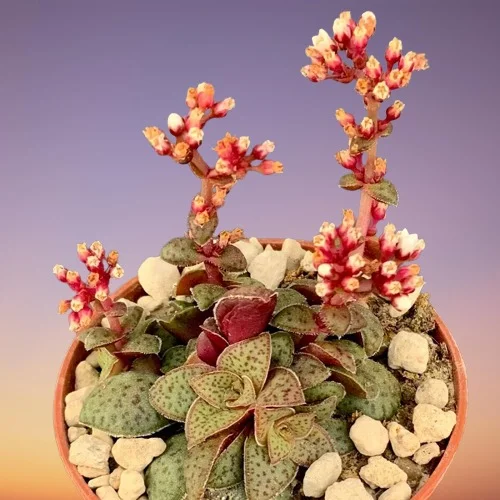
Crassula picturata commonly called Tiger Jade Crassula is a perennial succulent shrub with numerous stems on which are borne triangular, dark-green leaves with red spots and purple undersides.
Tiger Jade Crassula leaves are spirally arranged on the stem and usually develop a pinkish tinge in bright light or under direct sunlight placing it among the sun-loving plants perfect for a sunny spot.
Crassula picturata blossoms in bright light with at least 4-6 hours of direct sunshine, warmth of 15-260C, humidity of 50-55% and moderately moist, well-drained succulents soil coupled with monthly feeding during the growing season.
Learn more on how to grow and care for Crassula picturata
6. Silver Dollar Jade (Crassula arborescens)

Crassula arborescens commonly called Silver Dollar Jade or Silver Dollar Plant is among the popular succulent plants which bears rounded blue-gray leaves with maroon edges and small maroon speckles on the upper surface.
The small maroon speckles are technically called 'hydathodes' whose function is to help the plant absorb moisture from the atmosphere. They are especially useful in the plant's naturally dry environment.
Crassula arborescens flourishes in bright light with 4-6 hours of direct sunlight, warmth of 15-260C, humidity of 50-55% and moderately moist, rich, well-drained succulents soil coupled with monthly feeding in the growing period.
Read more on how to grow and care for Crassula arborescens
7. Crassula brevifolia (Crassula pearsonii)

Crassula brevifolia also called Crassula pearsonii is a small, much-branched, perennial, succulent shrub whose branches bear thick, fleshy, green, triangular-shaped leaves which turn yellowish-green in bright light.
The leaves have pink edges and small pink spots on the surface called hydathodes which are important for absorbing moisture from the air in their natural habitat.
Crassula brevifolia thrives in bright light with at least 4-6 hours of direct sunlight, warmth of 16-240C, humidity of 50-55% and moderately moist, well-drained succulents potting mix coupled with monthly feeding during the growing season.
Learn more on how to grow and care for Crassula brevifolia
8. Crassula Campfire (Crassula capitella 'Campfire')

Crassula capitella 'Campfire' commonly called Crassula Campfire, Campfire Crassula or Red Flames Plant with fleshy leaves and stems which store water allowing the plant to go for a considerably long period without being watered. Take care not to overwater this plant to prevent rotting.
Campfire Crassula is a perennial succulent with propeller-like, fleshy leaves which start off light-green and become a bright reddish color in bright light which makes this plant one of the best succulents for full sun.
Crassula capitella 'Campfire' prospers in bright light with about 4-6 hours of direct sunlight, warmth of 15-260C, humidity of 50-55% and moderately moist, rich, well-drained succulents soil coupled with monthly feeding during the growing season.
Read more on how to grow and care for Crassula capitella 'Campfire'
9. Sunglow Plant (Crassula coccinea)

Crassula coccinea commonly called Sunglow Plant or Red Crassula is a compact succulent plant whose stems are clothed with leathery triangular leaves which look like they are stacked on top of each other.
Sunglow Plant grows to a height of about 1-1.5 feet and bears showy clusters of red tubular flowers. On account of its compact size, Red Crassula is among the best plants for a sunny balcony.
Crassula coccinea thrives in bright light with 4-6 hours of direct sunlight, warmth of 15-240C, humidity of 50-55% and moderately moist, fertile, well-drained succulents soil coupled with monthly feeding during the growing season.
Read more on how to grow and care for Crassula coccinea
10. Crassula elegans (Elegant Crassula)
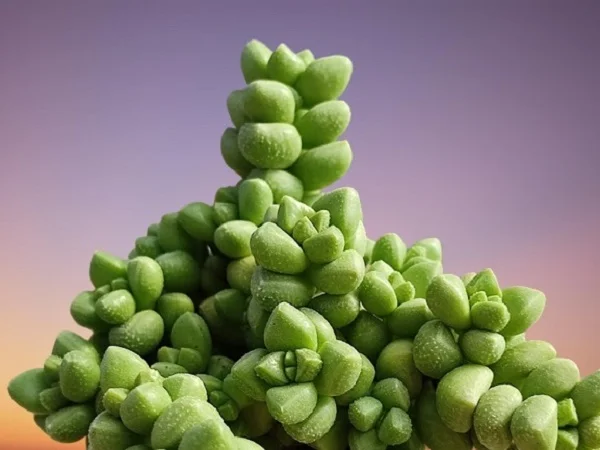
Crassula elegans commonly called Elegant Crassula is a compact, dwarf, much-branched succulent whose thin stems are densely packed with oval to triangular fleshy leaves occuring in 4 rows.
Elegant Crassula leaves are smooth or covered with fine hairs or coarse rounded papillae and are green to brown or purplish-red in color.
Crassula elegans blossoms in bright light with at least 4-6 hours of direct sunshine, warmth of 15-240C, humidity of 50-55% and moderately moist, well-drained succulents soil coupled with monthly feeding during the growing season.
Learn more on how to grow and care for Crassula elegans
11. Propeller Plant (Crassula falcata)
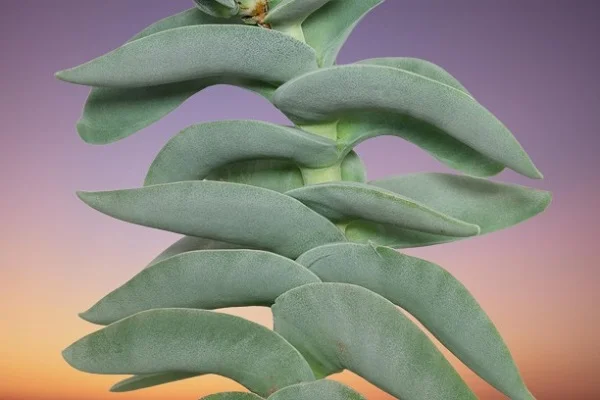
Crassula falcata commonly called Propeller Plant or Scarlet Paintbrush Plant is a single-stemmed plant which bears gray-green, succulent, propeller-shaped leaves and dense clusters of scarlet-red blooms.
Propeller Plant leaves grow around the stem in a slight angle and can grow to a length of 2 feet. The shape and growth pattern of the leaves give this plant the common names, Propeller Plant and Airplane Plant.
Crassula falcata flourishes in bright light with about 4-6 hours of direct sunshine, warmth of 15-260C, humidity of 50-55% and moderately moist, rich, well-drained succulents soil coupled with monthly feeding during the growing season.
Read more on how to grow and care for Crassula falcata
12. Fairy Crassula (Crassula multicava)
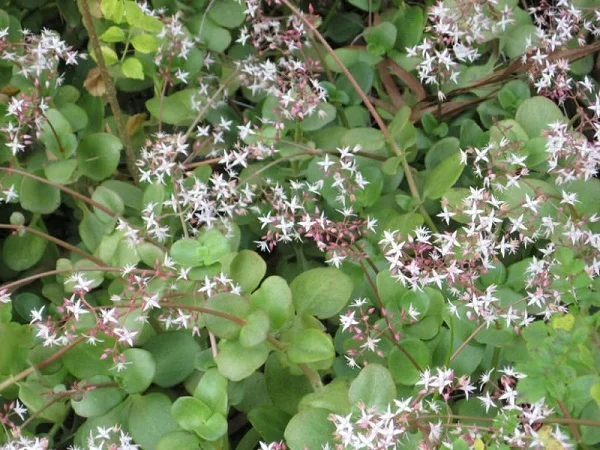
Crassula multicava commonly called Fairy Crassula or Pitted Crassula is a mat-forming succulent plant which bears glossy round leaves with tiny pores along the edges.
The small pores along the leaf edges are hydathodes which allow moisture absorption from the air. It is an important feature in its natural habitat where the conditions are generally dry.
Crassula multicava prospers bright light with at least 4-6 hours of direct sunlight, warmth of 15-240, humidity of 50-55% and moderately moist, rich, well-drained succulents soil coupled with monthly feeding during the growing season.
Learn more on how to grow and care for Crassula multicava
13. Watch Chain Plant (Crassula muscosa)

Crassula muscosa commonly called Watch Chain Plant, Rattail Crassula or Clubmoss Crassula is a much-branched succulent plant with tiny, scale-like, light-green leaves which are densely packed around a thin stem.
Watch Chain Plant leaves are arranged in opposite pairs around the stem in four rows which gives the stem a square shape. The stems start off erect but as they mature, they begin to trail due to the weight of the leaves placing this plant among the best plants for hanging baskets.
Crassula muscosa thrives in bright light with at least 4-6 hours of direct sunlight, warmth of 20-280C, humidity of 50-55% and moderately moist, fertile, well-drained succulents soil coupled with monthly feeding in the growing season.
Read more on how to grow and care for Crassula muscosa
14. Crassula Baby Necklace (Crassula rupestris)

Crassula rupestris commonly called Crassula Baby Necklace, Rosary Vine, Kebab Bush, Concertina Plant or Rock Crassula is a highly branched succulent whose thin stems are packed with thick, rounded-triangular leaves.
Crassula Baby Necklace leaves start off grey-green and change to creamy-yellow with rose-red (reddish) margins in bright light which resemeble a string of beads on a child's necklace hence the common name.
Crassula rupestris prospers in bright light with 4-6 hours of direct sunlight, warmth of 16-250C, humidity of 50-55% and moderately moist, well-drained succulents coupled with monthly feeding in the growing season.
Learn more on how to grow and care for Crassula rupestris
15. Variegated Showy Trailing Jade (Crassula sarmentosa Variegata)
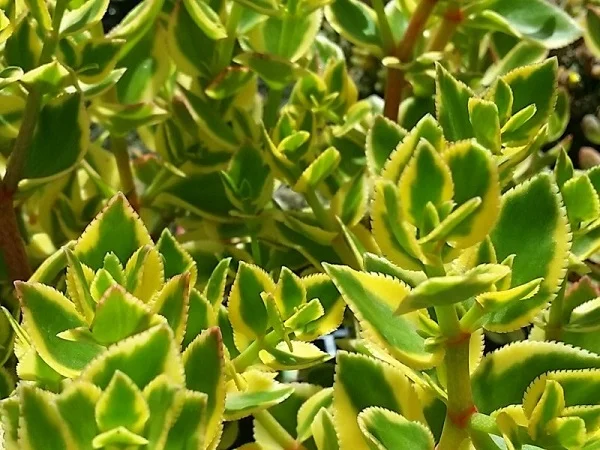
Crassula sarmentosa Variegata commonly called Variegated Showy Trailing Jade is a much-branched succulent plant with trailing stems and mid-green leaves with golden yellow serrated edges.
The stems in Variegated Showy Trailing Jade are reddish-pink to green mottled with white and are about 3.3 feet long which places this plant among the best hanging succulent plants for a hanging basket or pedestal where it can display its beauty.
Crassula sarmentosa Variegata blossoms in bright light with at least 4-6 hours of direct sunlight, warmth of 15-260C, humidity of 50-55% and moderately moist, rich, well-drained soil coupled with monthly feeding during the growing season.
Read more on how to grow and care for Crassula sarmentosa Variegata
16. Miniature Pine Tree (Crassula tetragona)

Crassula tetragona commonly called Miniature Pine Tree or Mini Pine Tree is an upright, naturally branching, shrubby succulent plant whose leaves are green to dark green and occur in crossed pairs.
The common name, 'Miniature Pine Tree', is in reference to the naturally branching form and interesting leaf structure of this spectacular plant.
Crassula tetragona flourishes in bright light with 4-6 hours of direct sunlight, warmth of 15-260C, humidity of 50-55% and moderately moist, rich, well-drained, succulents soil coupled with monthly feeding during the growing season.
Learn more on how to grow and care for Crassula tetragona


